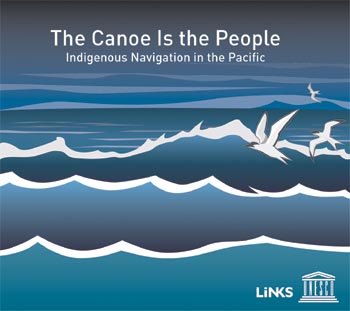
|
 |  |
 |
| Traditional Knowledge of Navigation possessed by Pacific Islands Peoples
|
|
 |
 |
 |

| "The compass can go wrong, the stars never." *
Tongan navigator
The Canoe Is the People CD-ROM
Indigenous Navigation in the Pacific Thousands of years ago, when most European sailors were still hugging the coast, the island peoples of the Pacific held the knowledge and skills to explore the great ocean paths around and beyond their homes. Modern instruments didn't exist - no compasses, no radio, no radar, no GPS. The Pacific peoples navigated their canoes with their own sophisticated techniques, using the seas, skies, and sea life to guide them. Launch hosted by the delegations of New Zealand, Australia, Fiji and Palau.
To order a copy write to links@unesco.org. For more information, read the brochure
|
Released 12 October 2005, The Canoe Is the People honours and explores the knowledge and skills of traditional Pacific navigation. It is designed for Pacific youth but will be of great interest to others as well. The cultures of the Pacific are diverse. For this reason, the story of navigation has many faces and is told in many ways. This CD-ROM celebrates the similarities and the differences in these traditions. The focus is on the island of Satawal in the Caroline Islands of the Federated States of Micronesia, where navigational knowledge is still very much alive, with substantial contributions from the Cook Islands and New Zealand. The CD-ROM also involves many examples from other parts of the Pacific. The CD-ROM responds to one of LINKS goals - revitalizing the transmission of indigenous knowledge by strengthening the dialogue between elders and youth. New ICT tools like CD-ROMs are recognized as powerful vehicles for traditional knowledge and the bolstering of oral traditions. The CD-ROM includes 70 videos, 41 stories and accounts, 40 images and diagrams, of which 11 are animated, in addition to numerous maps, photos and texts.  | The CD-ROM primarily serves as an educational tool illustrating the vitality of indigenous knowledge, know-how, and identity in meaningful ways for Pacific communities. It will also become part of an educational package to be proposed for integration into Pacific curricula. The Storehouse section contains an abundance of additional information: A glossary; museum references; book references; and the full printable text version of the CD-ROM. As such, it also acts as a reference resource helping local communities identify and gain access to a selection of archival materials lodged in distant locations. In this way, it contributes to a process of restitution of data to communities. After the introductory pages, the viewer is presented with the home page, which reveals the CD-ROM's 5 major components (Beginnings, Canoes & Sailing, Becoming a Navigator, Navigating, Voyages & Revival). Users are taken on a voyage from the very beginnings of the Pacific Islands and their discovery and occupation, through the challenges of building a canoe and becoming a navigator, to accounts of the modern-day exploits of Pacific voyagers and voyaging societies. The viewer can experience the exceptional opportunity to learn about reading swells from Satawalese master navigator, Mau Piailug, get tips on building a canoe from Satawalese senap (master canoe builder), Edward Remoi or even watch extracts of a recent pwo initiation ceremony for navigators. Learning navigation is a life-long process. That process is rooted in a web of cultural, social, and spiritual relations. For this reason, the CD-ROM does not aim to teach navigation. Instead, it gives people a taste of the wealth of knowledge that still survives in the Pacific region. It encourages young people to go into their own communities to find out more - to renew ties with elders and, by doing so, to take part in (and pride in) a voyage of revival. |
The Canoe Is the People is the second in a series of CD-ROMs created as part of UNESCO's Local and Indigenous Knowledge Systems (LINKS) project (www.unesco.org/links). The series uses new information and communications technologies to attract the interest and imagination of indigenous young people about their own knowledge systems. It supports the transfer of indigenous knowledge from elders to youth. This CD-ROM builds on an earlier UNESCO programme called Vaka Moana, aimed at preserving and developing Pacific culture and heritage, with an emphasis on canoes and voyaging. >> See related press release, Paddling full steam ahead: Traditional voyaging and navigation at the 9th Festival of Pacific Arts VOYAGE INTO THIS CD-ROM TO FIND OUT MORE!
 * From David Lewis in Bader, H. and McCurdy, P., eds (1999)
|
|
 |  |  |
|



